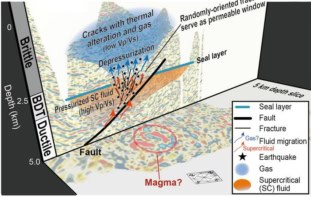Scientists in the US have witnessed the production of methane under the conditions that exist in the Earth's upper mantle for the first time. The experiments demonstrate that hydrocarbons could be formed inside the Earth via simple inorganic reactions -- and not just from the decomposition of living organisms as conventionally assumed -- and might therefore be more plentiful than previously thought.

Methane is the most abundant hydrocarbon found in the Earth’s crust and is also the main component of natural gas. Reserves of natural gas are often accompanied by petrol, usually only a few kilometres below the Earth’s surface. The possibility that hydrocarbons might exist deeper in the Earth’s mantle, or could be formed from non-biological matter, has been the subject of debate among geologists in recent years.
To explore these questions further Henry Scott of Indiana University in South Bend and colleagues at the Carnegie Institution in Washington, Harvard University and the Lawrence Livermore National Lab subjected materials commonly found in the Earth’s crust to temperatures of up to 1500°C and pressures as high as 11 gigapascals (Proc. Natl. Acad. Sci. to be published). These conditions are similar to those found in the Earth’s upper mantle.
Scott and co-workers squeezed together iron oxide, calcium carbonate and water between two diamonds with flattened tips while heating up the device. The advantage of the “diamond anvil cell” technique is that the sample can be analysed in situ — through the diamonds — using a variety of spectroscopic techniques. The US scientists found that methane was most readily produced at relatively low temperatures of 500°C and pressures of 7 gigapascals or below.
In 2002 J F Kenney of Gas Resources Corporation in Texas and co-workers in Moscow found methane and other hydrocarbons in similar experiments. However, their apparatus did not allow them to follow the formation process in situ (Proc. Natl. Acad. Sci. 99 10976).
Freeman Dyson of the Institute for Advanced Study in Princeton believes the results are important because they could help answer the question of whether natural gas and petroleum could be created inorganically. “If the answer turns out to be inorganic, this has huge implications for the ecology and economy of our planet,” says Dyson.
However, Scott is more cautious about his team’s results. “Although I believe the Earth’s mantle could contain a significant quantity of even heavier hydrocarbons, I cannot constrain how much of this reaches the Earth’s surface, or the extent to which it may augment resources that we exploit commercially,” he told PhysicsWeb. “I do not want to suggest in any way that these hydrocarbons are likely to represent an untapped energy reserve.”




